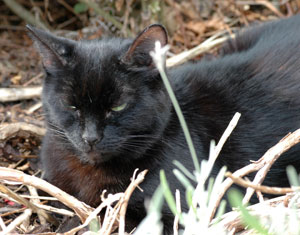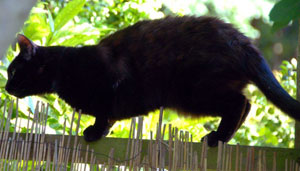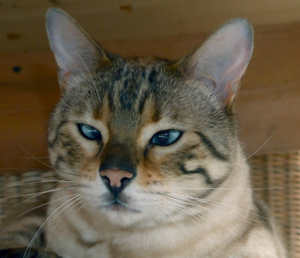Cats as predators

Cats have been been 'domesticated' for many thousands of years, and currently stand as the most popular pet in the world (according to Wikipedia). It has been suggested that the Egyptians were the first to domesticate the wild cat. Though the association with humans probably pre-dates their domestication, recent research suggests that cats were attracted to ancient farming villages - perhaps by the supply of rodents (rats / mice). It is possible that cats are descended from african wildcats that 'self - domesticated' somewhere in the Near East. A kitten has been found buried alongside human remains in Cyprus; this dates from some nine and half thousand years ago.
However, more recently, the BBC’s Wildlife program focused on domestic cats and wildlife.
There are approximately 10 million cats in the U.K. and they are predators even when they are well fed. In the BBC program / podcast, Rebecca Thomas discussed her research on the cat population in Reading. She ‘enlisted’ the help of some 250 cat owners; and e ach owner kept a ‘prey diary’ over a 2 year period, not continuously – but for six weeks in each of the seasons. This was important in that it allowed the seasonal changes in the pattern of predation to be analysed.
ach owner kept a ‘prey diary’ over a 2 year period, not continuously – but for six weeks in each of the seasons. This was important in that it allowed the seasonal changes in the pattern of predation to be analysed.
When the cats brought in prey, the volunteers rang or emailed Dr. Thomas This allowed her not only to identify the prey, but also to determine the sex of the animal, and whether it was ajuvenile or mature etc. In her results, wood mice accounted for some 40% of the prey . Wood mice are common in urban and sub-urban areas; interestingly , not a single house mouse was recorded.
Also recorded in the survey, were
- voles,
- shrews (pygmy and common), and
- birds such as robins and blackbirds.
Robins and blackbirds often feed on the ground and are an easier target than ‘tree types’. Some cats brought intact eggs back to the home; there was even the occasional weasel (which are small but quick predators themselves). Others managed pigeons and squirrels; these are large prey in comparison to the body size of a cat. The hunting 'effectiveness' of domestic cats varies quite considerably (circa a fifth of the cats brought back no kills to the home in a year, where another fifth brought back 4 or more kills in the same period).
 The high density of cats in urban areas is thought to affect the foraging behaviour of many garden birds. The cats probably also influence adult and juvenile survival of certain birds (see below). It is possible that cats are taking weak birds or birds that would have died anyway. Dr. Thomas also investigated ways in which cat owners might be prepared to help reduce this kill of birds and other wildlife -
The high density of cats in urban areas is thought to affect the foraging behaviour of many garden birds. The cats probably also influence adult and juvenile survival of certain birds (see below). It is possible that cats are taking weak birds or birds that would have died anyway. Dr. Thomas also investigated ways in which cat owners might be prepared to help reduce this kill of birds and other wildlife -
- banning cats in ecologically sensitive areas,
- the wearing of a bell or anti-predation device, keeping cats indoors during the day,
- declawing the cats
 The addition of a small bell, or an ultrasonic device - to the collar of a cat was seen as a reasonable option by most cat owners (as was mandatory sterilisation).
The addition of a small bell, or an ultrasonic device - to the collar of a cat was seen as a reasonable option by most cat owners (as was mandatory sterilisation).
Another study, by researchers at the Universities of Sheffield and Exeter, suggests that the killing birds by cats is just one aspect of the problem. Dr Colin Bonnington* at the University of Sheffield and colleagues investigated so-called sub-lethal effects. Sub-lethal pressures cause animals to change their behaviour, often in an effort to reduce their chances of being predated. The study suggests that the sight of a cat near the nests of blackbirds result in adult birds feed ing their chicks less often; and not just that, but the calls of the adult birds in 'defending their nests' end up attracting other predators like rooks, crows and magpies - thereby multiplying their problems.
 Various surveys and reports indicate the U.K’s bird population has dropped from 210 million in 1966 to 166 million in 2012. Many 'common' bird populations (e.g. House sparrows) have fallen in recent years (see, for example, a report in The Guardian ) occasioned by a number of factors : changing land use, climate etc.
Various surveys and reports indicate the U.K’s bird population has dropped from 210 million in 1966 to 166 million in 2012. Many 'common' bird populations (e.g. House sparrows) have fallen in recent years (see, for example, a report in The Guardian ) occasioned by a number of factors : changing land use, climate etc.
Cats are viewed as an invasive species in some parts of the world, and considered responsible for the decline or extinction of certain native species. In Australia, it has been estimated that there is a population of twenty million feral cats and these have been responsible for the decline of small marsupial species. However, it is on small islands that cats can have the most dramatic effects. Ascension Island used to be home to millions of seabirds (back in the Nineteenth Century) but by the year 2000, when a cat eradication program started, no sea birds nested on the main island.
For further information visit :
- http://planetearth.nerc.ac.uk/news/story.aspx?id=1337
- http://www.discoverwildlife.com/british-wildlife/understand-pet-cats-and-wildlife
- http://planetearth.nerc.ac.uk/news/story.aspx?id=1374
- 'Fearing the feline' - Journal of Applied Ecology / http://onlinelibrary.wiley.com/doi/10.1111/1365-2664.12025/abstract
Comments are closed for this post.
